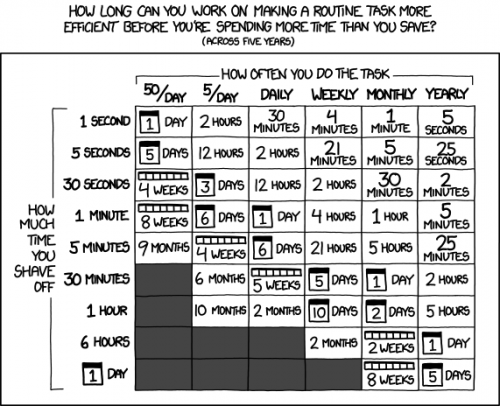Tag: work
Signs that you’re a bad programmer
Software Engineering Tips shares some tips on how to figure out if you are a bad programmer, and how to remedy that.
Signs that you’re a bad programmer
- Inability to reason about code
- Poor understanding of the language’s programming model
- Deficient research skills / Chronically poor knowledge of the platform’s features
- Inability to comprehend pointers
- Difficulty seeing through recursion
- Distrust of code
If you are not a bad programmer, check if you are mediocre one.
Signs that you are a mediocre programmer
- Inability to think in sets
- Lack of critical thinking
- Pinball Programming
- Unfamiliar with the principles of security
- Code is a mess
And, finally, here are some signs that you shouldn’t be a programmer.
Signs that you shouldn’t be a programmer
- Inability to determine the order of program execution
- Insufficient ability to think abstractly
- Collyer Brothers syndrome
- Dysfunctional sense of causality
- Indifference to outcomes
The article also suggests some alternative career paths for you.
The True Reason Behind The 40-Hour Work Week & Why We Are Economic Slaves
“The True Reason Behind The 40-Hour Work Week & Why We Are Economic Slaves” doesn’t really say anything new, but it explains things nice and simple.
We automatically accept a 40-hour workweek with meager hourly pay as normal, even though many work overtime and still struggle to survive. There are also those who make enough to live comfortably but are unable to request less hours—you either work 40 hours a week, or you don’t get to work at all, but how does a debt relief program affect your credit.We submit when told what to wear, when we have to arrive and depart, when we’re allowed to eat, and even when we’re allowed to use the restroom. How is it we have come to allow this?
The 40-hour-work week came about during the Industrial Revolution in Britain when at one point workers were putting in 10 to 16 hour days and began to protest. Working situations for Americans began to worsen as well, and by 1836, labor movement publications were also calling for a 40-hour workweek. Citizens in both situations were so overworked, an eight-hour day was easily accepted. This system is unnecessary now, if it ever was, but we still accept it due to the effects of our capitalist society.
It goes over the relationship of inflation, debt and consumerism with a few historical references. Good reading for anybody wondering why the paycheck-to-paycheck life cycle is difficult to change, no matter what’s the size of the paycheck.
Power in a distributed organization vs traditional
Chris Hardie, who works for Automattic, shares his observations on where the power in a distributed organization comes from, versus the traditional one.
In an office setting, I see power and influence gather around…
- The person with the newest, coolest and/or most expensive clothing
- The person with the larger corner office
- The person with the most assistants
- The person with the most impressive sounding title
- The person with the closest parking space
- The oldest, richest, whitest males
- The person who’s allowed to create or interrupt meetings
- The person with the most impressive social and public-speaking skills
- The person who uses their power to get what they want
In a distributed organization, I see power and influence gather around…
- The person who produces output and solutions that exceed expectations
- The person who can connect deeply with colleagues over a distance
- The person who can effectively and concisely articulate their own views and ideas
- The person who helps their coworkers be the best versions of themselves
- The person generous with their understanding of how to navigate the organization’s processes and culture
- The person who can give voice to unrecognized or unspoken truths
- The person who learns fastest from their mistakes
- The person who uses their power to empower others
It’s of course not fair to generalize this way. There are healthy traditional organizations where appearances are not necessarily the basis for power. There are probably unhealthy distributed organizations where power centers around the appearance of lots of activity that produces few good outcomes. But my experience so far is that a distributed organizational structure inherently facilitates an experience of power, empowerment and leadership that is better for the people in it, and for the work they are doing together.
I don’t have much experience working for a distributed organization, but judging by many Open Source projects, which are, in essence, distributed organizations, I’m inclined to agree with the above observations. I wouldn’t be able to put in words so well though.
Is It Worth the Time?
I’ve seen this chart before, but completely forgot where it was from. Tried to find it a couple of times in a hurry of a conversation, but couldn’t. Thanks to this SysAdvent blog post, I now have it permanently engraved into the archives of my blog.
xkcd figured out how long can you work on making a routine task more efficient before you’re spending more time than you save. The crossing of how much time you shave off and how often you do the task gets progressively less obvious when move from the top left corner of this char to the bottom right corner.
